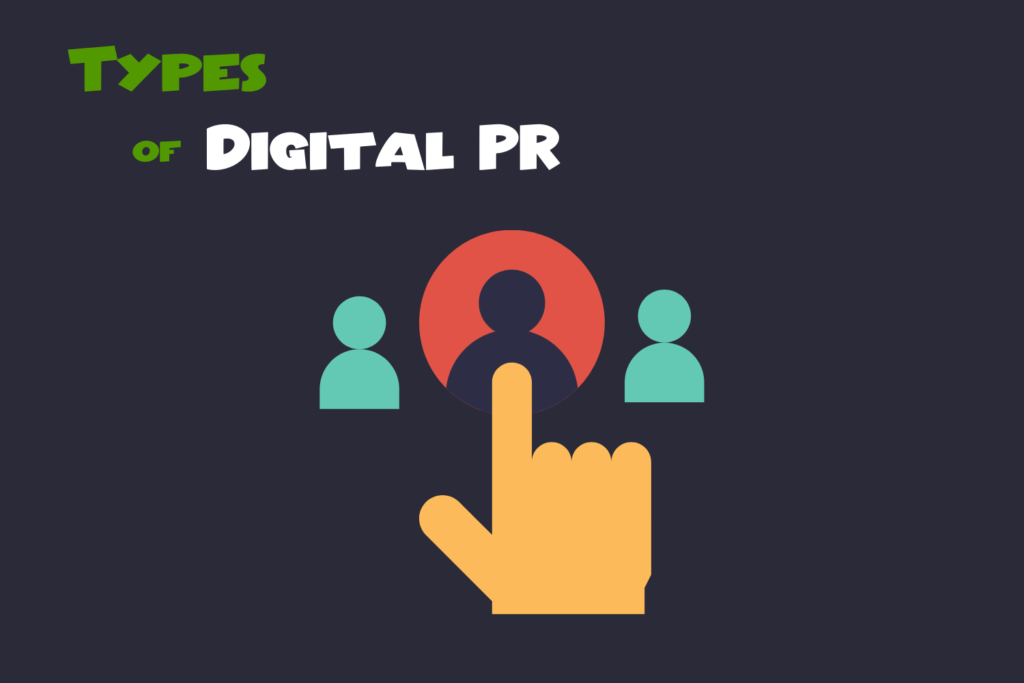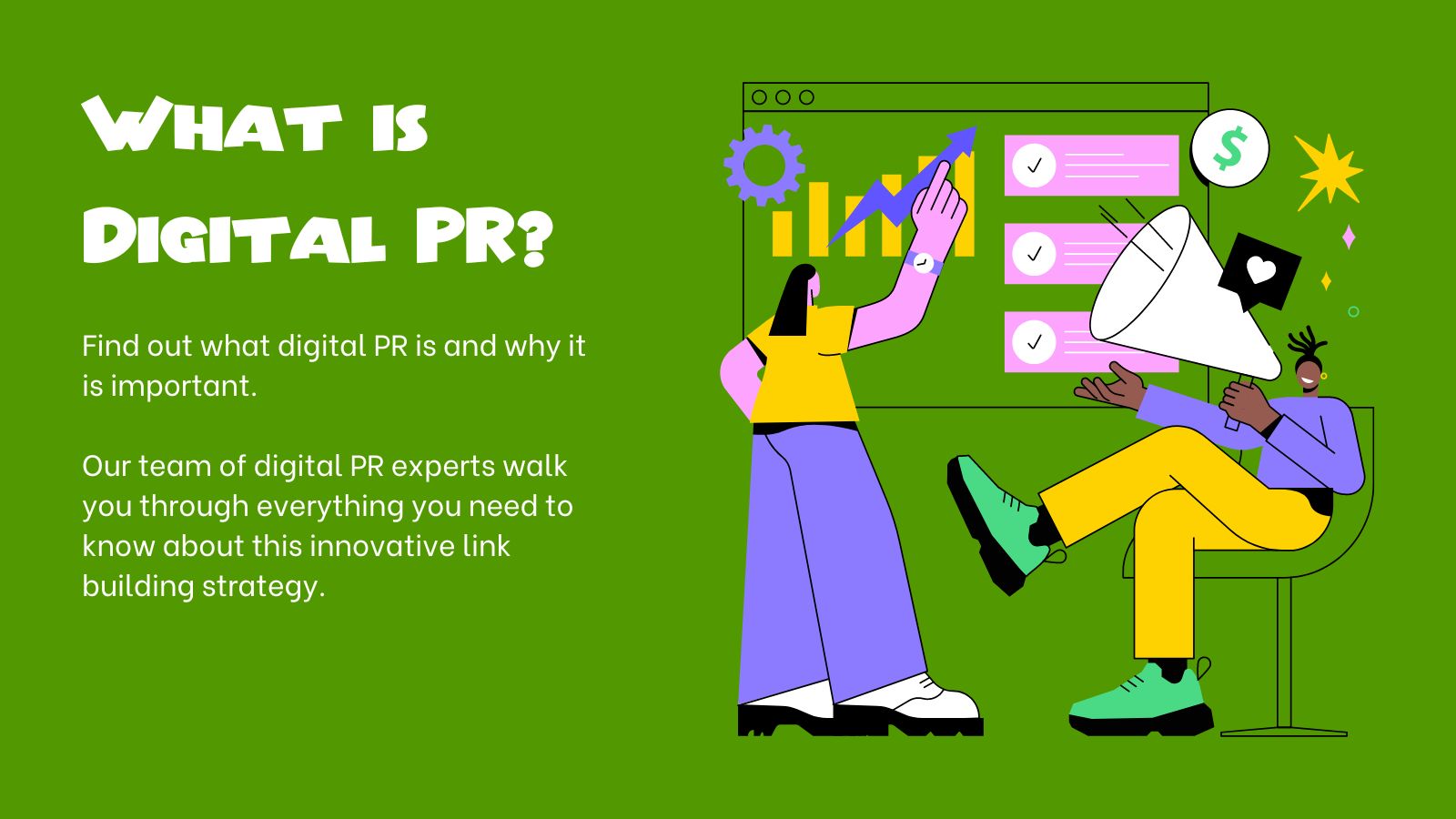Digital PR is a strategy used to promote a business online and build brand awareness.
It is often used with a focus on earning backlinks from high authority websites and publications to support wider search engine optimization (SEO) efforts.

The strategy involves communicating with journalists, bloggers, influencers and/or other respected individuals or organizations within a given industry.
Why is Digital PR Important?

When someone types a few words into Google, they expect to see relevant, high-quality information.
Behind the scenes, there is a symphony of action working hard to make sure that this happens.
On the other side, countless websites attempt to reach the top of the search results most relevant to their websites and content.
This ongoing struggle is a centerpiece of modern marketing and especially of digital PR.
A solid digital PR strategy helps websites demonstrate to Google and other search engines that they are a reliable source of high-quality information.
It helps show that the brand gaining widespread industry attention deservers to rank at the top of the search results for relevant keywords.
This is why digital PR is important.
What is Public Relations?

You can’t fully understand the meaning of digital PR without understanding what public relations is first.
Merriam Webster defines public relations as a professional practice that induces people to have a favorable image towards a company, an institution or a person.
Public relations in the digital world is still trying to achieve the same thing, only through the modern forms of communication that we all use today.
The historical timeline from The Museum of Public Relations shows that PR has basically been around for as long as cave paintings have. Just since people communicate digitally now, PR agencies need to use modern methods and mediums.
Most people use their computers, smartphones, and tablets to interact with the world. Discovering relevant information is as easy as entering a few words into a search engine. That’s why digital public relations strategies aim to increase search engine performance.
What is digital PR?
It is the business of convincing search engines to have goodwill toward a website or company, most often through backlinks.
Digital PR & SEO
Some say that digital PR is a vital part of any successful search engine optimization (SEO) strategy, or a content marketing one. Others contend that it’s simply modern public relations.
Almost everyone will agree though that digital PR’s meaning is to generate high-quality backlinks to ultimately increase organic traffic received via search engines.
In the rest of this post, we’ll walk through the remaining basics behind answering “what is digital PR?”, starting with some background and SEO understanding, then uncovering the true digital PR meaning.
We will then wrap things up by going over the techniques used in successful digital PR strategies, and consider what the future of digital PR might look like.
Search Engine Optimization
Search Engine Optimization, more commonly called SEO, is how websites increase the quantity and quality of traffic they receive from search engines.
By understanding how search engines work, website owners and marketers can optimize their content to better target and serve relevant keywords.
People use a wide range of different SEO techniques to help ensure that their website(s) show up highly in the search results for relevant keywords.
Google tries to be transparent about how its search engine works by providing public information about the search engines inner workings.
Google uses complex algorithms to rank the billions of web pages available online. Doing this ensures that the content returned to searchers in the search results is relevant, useful and provides the answers that they are looking for.
Now, within Google’s algorithms are many factors to identify if a website is relevant to the search being carried out.
Some of these factors are straightforward, like if your page includes the words used in the search term (known as keywords). Others are more complex like if your website makes effective use of schema markup.
Another factor is how authoritative and trustworthy the website is, often gauged by looking at backlinks pointing to the website.
What is a Backlink?
When another website links to a page on your website, this is called a backlink.
Google examines how many of these links exist and uses that to rank the pages, especially when the backlinks come from a website with a lot of expertise in the same field as the website being linked to.
Backlinks might be one of the most important ways that Google determines what information to show top in their results.
Google’s founders Larry Page and Sergey Brin filed a patent back in 1998 based on this technique. The patent states “the rank assigned to a document is calculated from the ranks of documents citing it.”
Backlinks are at the heart of digital PR.
By generating additional quality backlinks, search engines are encouraged to take that work and website more seriously and will hopefully rank them higher for relevant keywords as a result.
Digital PR from Years Ago
When website and business owners started to understand how critical backlinks were in search engine algorithms, they used numerous techniques to generate the links.
It was likely at this point that the world of digital PR was born.
Unfortunately, some of the other early link building techniques were not entirely honest.
Rather than rely on relevant sources to link to the information because it was really worth linking to, some people turned to generating massive amounts of backlinks through manipulative practices.
These black-hat techniques, named after the hats of bad guys in old western movies, would generate many inappropriate and often irrelevant backlinks.
SEOs would manufacture links in many ways, like by purchasing them directly from popular websites.
These manipulative practises were such a problem that Google pushed out an update to its algorithm to combat this shady practice.
The Penguin Update, which rolled out in 2012, was specifically designed to reduce the effect and influence of manipulative link-building practices.
By doing this, Google laid the foundations for more respectable link building methods like digital PR to take hold.
Now that companies and websites weren’t able to purchase links without risking adverse reactions from search engines, they needed to find practical ways to become relevant so that other websites would choose to link to them.
As a result, the masters of digital PR were and remain to this day in very high demand.
Digital PR is Broad
So, it is clearly difficult to apply one single definition to the subject of digital PR.
It is still a growing field, and what it means to be digital is constantly evolving.
In fact, if you ask a few SEO experts to give their opinion on what digital PR is, the responses will vary greatly.
People will claim it is anything from the unflattering “link-building” to the more advertising-focused “thought leadership”.
Still, digital PR’s meaning for most people is the practice of taking specific actions to generate quality backlinks from other websites that ideally have a lot of authority and relevancy.
The actions taken to generate quality digital PR links and coverage are the trade secrets of the online PR firms engaged in the practice.
However, they can include things such as:
- Generating news-worthy stories
- Issuing press releases
- Networking with journalists and bloggers
- Publishing cool new interactive tools
- Creating affiliate programs
- Simply asking for credit when others have used your work without linking
In short, any effort to acquire new quality backlinks from relevant websites could be considered a part of digital PR.
Types of Digital PR

So, now we know that digital PR is simply the earning of links via data-driven and creative content marketing campaigns, how do we go about doing it?
Well first we need to understand the key types of digital PR.
News Publications & Journalists

The world of public relations has depended on news publications and journalists since its inception.
After all, what easier way is there to influence public opinion than by going straight to the most common sources of information?
What is digital PR for these companies?
It is a way to get engaging news articles and stories.
If done well, the major news publications love digital PR as it gives them the ability to do their job.
Some digital PR companies focus on producing news-worthy stories for BBC News, the NY Times, Wall Street Journal, and more well-known publications.
When these major publications post the stories, they will include links to the clients’ websites.
This results in a boost to the website’s Google performance and traffic.
Digital PR companies provide interesting stories with engaging backgrounds. One that a journalist wants to cover, investigate in more detail, and write about. Press releases or more informal channels are two techniques.
Rubbing elbows and networking with the right people and journalists can be an important part of digital PR.
When someone gains a reputation for providing interesting leads, they can spoon-feed journalists’ topics and content, and earn consistent top-tier links to their clients websites.
After seeing links from news organizations, Google boosts its clients’ web traffic.
Interactive Tools & Infographics

Another way to accomplish the main aim of digital PR, to earn quality backlink back to your website, is to produce specific tools and/or infographics that are useful or interesting to others in the field.
By creating a helpful tool or graphic, authority figures can link to that tool regularly and drive traffic to the website.
For example, if you’re starting up a real estate agency but don’t have a lot of online presence yet, it might be difficult to appear near the top of the organic search results. So you hire a digital PR agency to help out.
The first thing they do is create a mortgage calculator based on your target area’s needs. By doing so, other people find the mortgage calculator and might provide a link to it. Boosting search results.
Next maybe they’d reach out to their favorite journalists too. Those who covers real estate topics.
They will get them to check out the brand new mortgage calculator on the client’s website and include a link in their next article on the subject.
Another example is a recent interactive tool we built.
It is called the ‘You Vs a Billionaire’ salary calculator, and we sent it to journalists writing about tech and business.
Within a few days we had some huge websites like The Sun, Mental Floss and MSN linking to our website.
A great result and easy example of effective digital PR.
Affiliate Networks & Programs

Another technique used by some more old school digital PR’s is the creation of affiliate networks and programs.
Companies offer commissions to journalists, bloggers, and influencers to promote their products, and get their brands, products and/or services mentioned in their publications as a result.
By giving a financial incentive, these networks can generate countless links back to the target website.
There is a major downside to this type of digital PR, however. These links need to follow specific rules from Google.
You can find more about these affiliate rules directly from Google.
In sum, the website has to tag each link as sponsored and identify that a commission is being earned for the promotion.
This is an area where the old-school methods are going away, replaced with more honest information. And this is a big part of modern digital PR meaning.
Asking for Credit

It’s not uncommon for some websites to use another’s information, graphics, or other products without providing credit.
While this type of plagiarism is often protected through various copyright and intellectual property laws, it can be tough to enforce.
Digital PR agencies can use this to their advantage though.
They’ll search for uncredited work and then ask for proper credit. By asking for a proper link (which probably should be there in the first place), the website receives a boost in traffic and potentially in the search results.
This is not an easy task though.
Finding specific information in the billions of pages on the internet is difficult, even for the savviest tech people.
In this form of digital PR, the website gets to keep the information it posted, while the original creator gets credit and an additional backlink, potentially boosting their search results and overall traffic.
What is Digital PR’s future?
While Google and other search engines have come a long way, they are certain to evolve more.
Google will get better at recognizing quality digital PR, while dishonest practices are likely to receive punishment.
Some people still see a problem with the algorithms prioritizing traffic from paid advertising. They don’t always show the best information.
In a 2021 tweet, Yoast Developer Jono Alderson said:
“…glorifying digital PR, overdoing the hard work of *being a good solution to the problems of an audience* is bad for brands and the web. I want a search engine to return the best results, not the company which paid an agency the most to launch a fancy microsite.“
What is digital PR’s future?
I don’t think anyone can answer that with certainty.
Google is likely to continue clamping down on providing more traffic to people who pay for it.
Instead, they will get better at recognizing when the content is what the people are looking for.
At the end of the day, answering “what is digital PR?” is as simple as answering “how do search engines work?”.
These questions will both change over time and are an attempt to get the best information in front of the people looking for it.
What is Digital PR – Wrap Up
If you’re looking to uncover the digital PR meaning, then you should start by understanding the world of public relations. Public relations experts have been routinely trying to get favorable opinions of their clients into the world.
Search engines and online presence drive today’s digital world. What is digital PR in a digital world? It is public relations techniques aimed at boosting online presence and search result rankings.
Digital PR agencies can use a variety of tactics to generate web traffic, but for the most part, they focus on obtaining quality backlinks from authoritative websites.
They might focus on getting picked up by major news publications through creating newsworthy stories or general networking. Or perhaps they use interactive useful tools and infographics to gain backlinks from industry peers who use their products. Affiliate programs and asking for credit are two other ways digital PR can be done.
The world of digital PR is vast and there are many techniques to accomplish it. What worked yesterday isn’t allowed today, and what works today might not be an option tomorrow.
Asking ‘What is digital PR?’ could yield much different answers depending on who, or when, you ask it.


